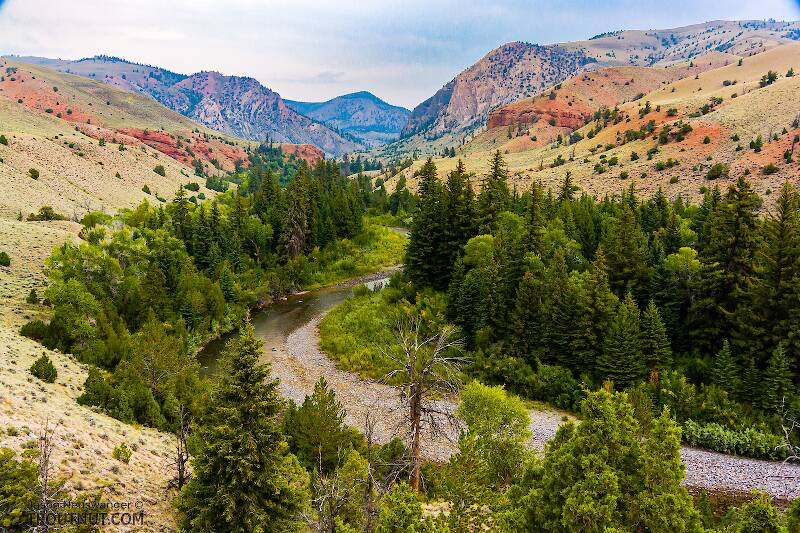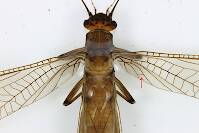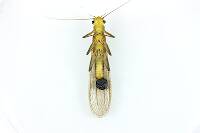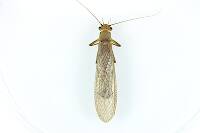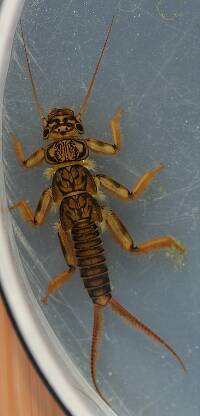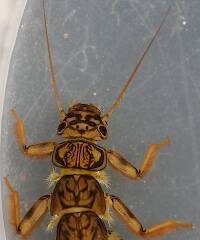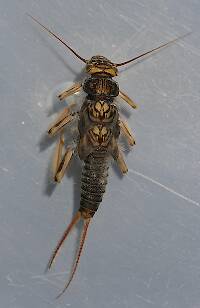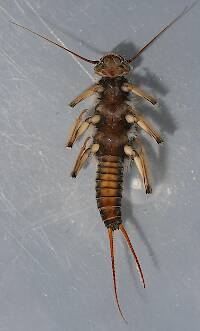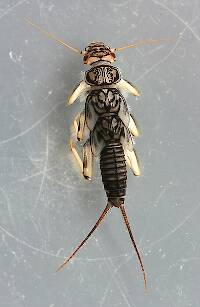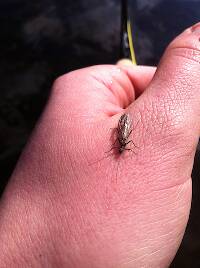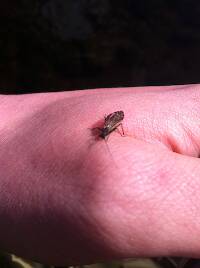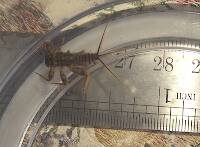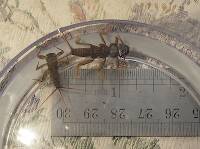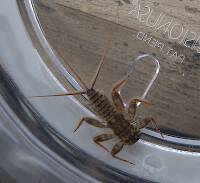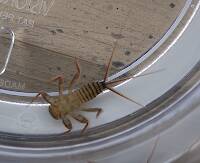
Blue-winged Olives
Baetis
Tiny Baetis mayflies are perhaps the most commonly encountered and imitated by anglers on all American trout streams due to their great abundance, widespread distribution, and trout-friendly emergence habits.
Featured on the forum

This specimen appears to be of the same species as this one collected in the same spot two months earlier. The identification of both is tentative. This one suffered some physical damage before being photographed, too, so the colors aren't totally natural. I was mostly photographing it to test out some new camera setting idea, which worked really well for a couple of closeups.

Troutnut is a project started in 2003 by salmonid ecologist Jason "Troutnut" Neuswanger to help anglers and
fly tyers unabashedly embrace the entomological side of the sport. Learn more about Troutnut or
support the project for an enhanced experience here.
This topic is about the Stonefly Genus Helopicus
Example specimen
Walleye on Jan 7, 2014January 7th, 2014, 2:26 pm EST
I have observed the Helopicus subvarians (springtime stonefly) for over 30 years on many of New Yorks Rivers, such as Beaverkill/Willowwemoc, Ausable (both east and west branch), West Canada Creek, and several others. Most of this time I believed it to be Acroneura nigrita ( Black Willow Stonely) as described by Ernest Schwiebert (Nymphs). Very distinct about the coloring of this Staonely is the last (rearward) sternites are very yellow (Ausable almost orange) while the riest is mostly black top and bottom. The thorax is again very distinctly marked with yellow (orange) with black on top. It is a most beautiflul stonefly, and is see it in May and June. It is well represented by the Montana Nymph is Black with yellow.
Every trout is a trophy!
Walleye on Jan 7, 2014January 7th, 2014, 3:34 pm EST
First sorry for the mistakes, computer waws acting up at time! Secondly now that I have further researched both Helopicus subvarians, and Acroneura nigrata (now Hesperoperla pacifica), I do not think the pictures of Helopicus subvarians are acturate, at least not the pictures of these tow stoneflies on the many sites I looked at. I do know the pictures as shown on Troutnut are the stonefly that I have been seeing for many years. Plus Schwieberts description in the 1st book NYmphs Acrooneura nigrita alias Black Willow Fly is a perfact description of the Pictures on the Troutnut site. However it is listed as Heloicus subvarians. Photos from other research indicates that neither one is right.
Every trout is a trophy!
Taxon on Jan 8, 2014January 8th, 2014, 9:27 am EST
The following question was sent to me by Walleye.
Hi William,
The Perlids known from NY are:
Acroneuria abnormis - Common Stone
Acroneuria arenosa - Eastern Stone
Acroneuria carolinensis - Carolina Stone
Acroneuria lycorias - Boreal Stone
Agnetina capitata - Northern Stone
Agnetina flavescens - Midwestern Stone
Attaneuria ruralis - Giant Stone
Eccoptura xanthenes - Yellow Stone
Neoperla occipitalis - Atlantic Stone
Paragnetina immarginata - Beautiful Stone
Paragnetina media - Embossed Stone
Perlinella drymo - Striped Stone
Perlinella ephyre - Vernal Stone
IMHO, your time would be better spent focusing on the candidates on that list. However, if you can take a decent macro photo of the stonefly you have been fishing over for 30 years in Upper NY, I may be able to identify it.
Best regards,
I’m questioning the relisting or reclassification of Schwieberts “Black Willow Fly” (Acroneura nigrita), which you have listed as Hesperoperla Pacifica. The picture and description by Schwiebert looks nothing like H. pacifica in photos or description in other literature listings. Plus in the on line site of Troutnut.com they list a stonefly: Helogicus subvarians, and the pictures do match that of Schwieberts. I have been seeing the stonefly pictured in Troutnut for over 30 years in upper NY (Beaverkill area, Ausable east/west branches, and West Canada Creek. When I further researched Helogicus subvarians, other literature does not match the photos by Troutnut, nor is the size the same. The ones I have been seeing are about 30mm, and are the same ones as those pictured in Troutnut. Schwieberts description and picture are very close to those at Troutnut. However at this point I do not know who is correct: Troutnut’s picture is the stonefly I have seen and collected, but I do not think it is H. subvarians. Schwiebert description seems to be on line with that of Troutnut’s picture. However you have relisted Acroneura nigrita as Hesperoperla pacifica, and the pictures and descriptions in other texts do not match. Can you help, or give me a source to contact.
Hi William,
The Perlids known from NY are:
Acroneuria abnormis - Common Stone
Acroneuria arenosa - Eastern Stone
Acroneuria carolinensis - Carolina Stone
Acroneuria lycorias - Boreal Stone
Agnetina capitata - Northern Stone
Agnetina flavescens - Midwestern Stone
Attaneuria ruralis - Giant Stone
Eccoptura xanthenes - Yellow Stone
Neoperla occipitalis - Atlantic Stone
Paragnetina immarginata - Beautiful Stone
Paragnetina media - Embossed Stone
Perlinella drymo - Striped Stone
Perlinella ephyre - Vernal Stone
IMHO, your time would be better spent focusing on the candidates on that list. However, if you can take a decent macro photo of the stonefly you have been fishing over for 30 years in Upper NY, I may be able to identify it.
Best regards,
Walleye on Jan 8, 2014January 8th, 2014, 2:03 pm EST
It is without a doubt the some one as pictured in Troutnut, under the name Helogicus subvarians. But other texts under that species show a differant stonefly. The closes I came to other than Schwieberts "Black Willow Fly", is Isoperla slossanae, which is also listed a a springfly as that of H. subvarians. The unit thing with both nymph and adult is that the last one or two segments by the tail are very bright golden yellow, almost looking like a large egg sac,(which it is not) See Troutnut pic of H. subvarian to see this feature. Pthe rest of the body is black top and bottom. The thorax is more golden yellow then black , and is nicely marked on top. There is know doubt the pic on Troutnut are the Stonefly I have been seeing , tying and catching fish on for many years. I would just like to really know it's actually scientific name. I have been calling it the Black Willow fly for many years, at least since I first got Schwieberts book. I actually fished with Ernie on the Broadheads, and he singed my cop of Nymphs on one of those trips. However at the time this was not an issue.
Every trout is a trophy!
Entoman on Jan 8, 2014January 8th, 2014, 4:44 pm EST
Hi William,
It sounds like you are indeed describing Helopicus subvarians a species of perlodid or "Springflies". This particular species has no commonly used angler name that I'm aware of. However, there is a scientific common name that perhaps Roger can provide.
Large perlodids (Springflies) are easy to confuse with the normally larger perlids (Common Stones, Golden Stones, among other names) as they are very similar in conformation, but they are an entirely different family. The easiest way to tell them apart is the big perlid nymphs will usually have obvious plumose thoracic gills. The big perlodids they can be confused with lack these. Also, adult perlid males will have hammers underneath their lower abdomen and (usually) longer wings. Females are tougher, but perlids will have (again usually) much shorter tails.
As for the rest of the confusion, you had the double misfortune of mistaking your critters for one of Schwieberts mistakenly labeled diagrams and descriptions in Nymphs 1. Somehow, he mislabeled a dark form of Acroneuria licoras (Eastern Common Stonefly) as Acroneuria Nigrita a dark species of golden Stone found in the Southwest. No explanation was given for the error though he did acknowledge it in his footnotes in Nymphs 2 published posthumously a few years ago. Since it is highly doubtful he would have knowingly confused his eastern sample for a western species he must have gotten his samples mixed up somehow. Considering the hundreds of species and thousands of specimens he dealt with....
Now for the triple whammy. It has been determined that Acroneuria Nigrita is actually a regionally adapted dark form of the common Hesperoperla pacifica. It's previous name is now obsolete.
Hope this isn't clear as mud and actually helps!
Best,
It sounds like you are indeed describing Helopicus subvarians a species of perlodid or "Springflies". This particular species has no commonly used angler name that I'm aware of. However, there is a scientific common name that perhaps Roger can provide.
Large perlodids (Springflies) are easy to confuse with the normally larger perlids (Common Stones, Golden Stones, among other names) as they are very similar in conformation, but they are an entirely different family. The easiest way to tell them apart is the big perlid nymphs will usually have obvious plumose thoracic gills. The big perlodids they can be confused with lack these. Also, adult perlid males will have hammers underneath their lower abdomen and (usually) longer wings. Females are tougher, but perlids will have (again usually) much shorter tails.
As for the rest of the confusion, you had the double misfortune of mistaking your critters for one of Schwieberts mistakenly labeled diagrams and descriptions in Nymphs 1. Somehow, he mislabeled a dark form of Acroneuria licoras (Eastern Common Stonefly) as Acroneuria Nigrita a dark species of golden Stone found in the Southwest. No explanation was given for the error though he did acknowledge it in his footnotes in Nymphs 2 published posthumously a few years ago. Since it is highly doubtful he would have knowingly confused his eastern sample for a western species he must have gotten his samples mixed up somehow. Considering the hundreds of species and thousands of specimens he dealt with....
Now for the triple whammy. It has been determined that Acroneuria Nigrita is actually a regionally adapted dark form of the common Hesperoperla pacifica. It's previous name is now obsolete.
Hope this isn't clear as mud and actually helps!
Best,
"It's not that I find fishing so important, it's just that I find all other endeavors of Man equally unimportant... And not nearly as much fun!" Robert Traver, Anatomy of a Fisherman
Walleye on Jan 9, 2014January 9th, 2014, 4:55 am EST
Thanks for your reply. Hoping that Roger can identify. As I look for the answer myself,(just from pictures) a stoneflly Perlinodes asurea looks alot like it, but thats listed for the west. Troutnuts picture of the Helopicus subvarian is the stonely I see all the time. If that is actually H. subvarian, then case is solved. My problem is that when I went to othe sites, and texts they only had a picture of the nymph (H subvarians) and that did not look like the ones I have found. Interesting to add to this the ones I seen and caught on the Ausable (late May/June) are almost orange on the tip and thorax area.
Every trout is a trophy!
Entoman on Jan 9, 2014January 9th, 2014, 11:30 am EST
You're welcome. You can have confidence that the photo here is of subvarian. As far as the nymphs go, the web is full of erroneously labeled photos. If your nymphs are as large as the adults and lack fluffy gills, you have your perlodid.:) Pretty unique critter and I can't think of another it could be confused with. Isoperla slossonae is a stripetail or Yellow Sally. It's smaller, slenderer, paler appearance rules it out.
"It's not that I find fishing so important, it's just that I find all other endeavors of Man equally unimportant... And not nearly as much fun!" Robert Traver, Anatomy of a Fisherman
Quick Reply
Related Discussions
Topic
Replies
Last Reply
1
Oct 28, 2008
by GONZO
by GONZO
2
Jan 19, 2010
by Dkak
by Dkak
9
Jun 17, 2015
by Oldredbarn
by Oldredbarn
1
Jan 29, 2016
by Martinlf
by Martinlf
1
Mar 9, 2012
by Wiflyfisher
by Wiflyfisher
6
Jan 4, 2010
by Konchu
by Konchu

